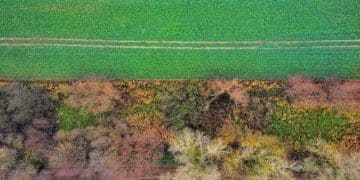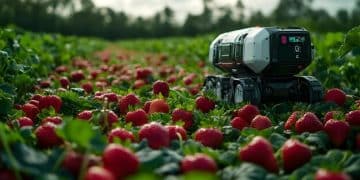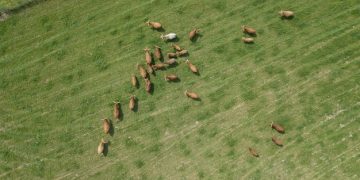Precision Irrigation: Smart Sensors Cut Water Waste by 20%
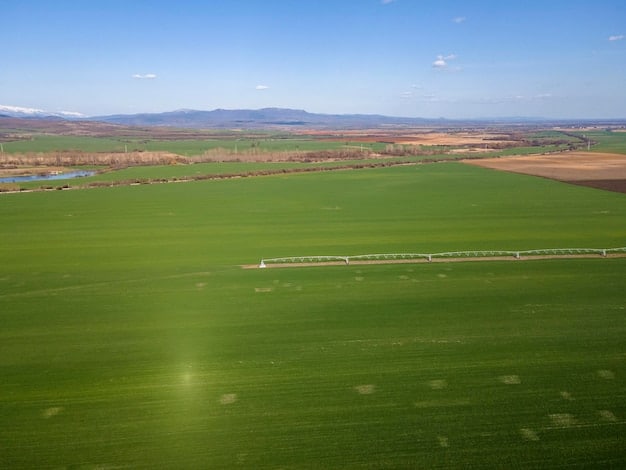
Precision irrigation uses smart sensor technology to optimize water usage in agriculture, potentially reducing water waste by up to 20% through real-time monitoring and automated adjustments based on specific crop needs and environmental conditions.
In the face of increasing water scarcity and environmental concerns, the agricultural sector is turning to innovative solutions. **Precision Irrigation: Reduce Water Waste by 20% with Smart Sensor Technology in US Agriculture** is not just a possibility, but a necessity. This article explores how smart irrigation systems, powered by cutting-edge sensor technology, are revolutionizing farming practices across the United States, promising substantial reductions in water wastage and increased crop yields. Let’s dive into how this technology is shaping the future of sustainable agriculture.
Understanding Precision Irrigation
Precision irrigation, at its core, is about delivering the right amount of water to the right place at the right time. It moves away from traditional, blanket irrigation methods that often lead to overwatering and inefficient water use. But how does it actually work?
This method utilizes an array of technologies, including soil moisture sensors, weather stations, and satellite imagery, to gather real-time data about crop water needs. This data is then used to precisely control irrigation systems, ensuring that crops receive only the water they need, when they need it. Let’s explore further some of the core principles.
Key Components of Precision Irrigation
Precision irrigation systems are complex, involving several key components working together to achieve optimal water use. Here’s a closer look at some of those components:
- Soil Moisture Sensors: These sensors measure the water content in the soil at various depths, providing critical data about the availability of water to plant roots.
- Weather Stations: On-site weather stations collect data on rainfall, temperature, humidity, and wind speed, helping to predict crop water needs based on evapotranspiration rates.
- Automated Control Systems: These systems use the data collected by sensors and weather stations to automatically adjust irrigation schedules, ensuring that crops receive the precise amount of water they need.
- Variable Rate Irrigation (VRI): VRI technology allows farmers to apply different amounts of water to different parts of a field, based on variations in soil type, topography, and crop needs.
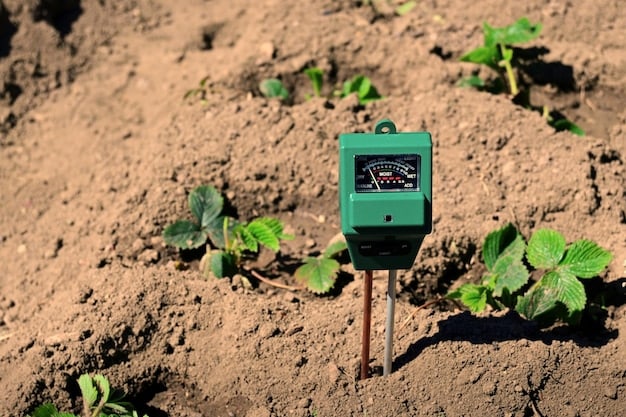
By integrating these components, precision irrigation systems offer a significant improvement over traditional irrigation methods. This leads to substantial water savings, improved crop yields, and reduced environmental impact.
Benefits of Implementing Smart Sensor Technology
The integration of smart sensor technology into irrigation systems brings a host of benefits, particularly for US agriculture. These advantages span economic savings, environmental protection, and increased productivity. What concrete benefits can farmers expect?
The most immediate benefit is a reduction in water usage. By precisely matching water application to crop needs, smart sensors help avoid overwatering, a common problem with traditional irrigation systems. We will explore further the impacts on environment, yields, and operational costs.
Water Conservation
Water conservation is a critical benefit of precision irrigation. Traditional irrigation methods often lead to significant water wastage due to:
- Overwatering: Applying more water than crops can use.
- Runoff: Water flowing off the field and into nearby waterways.
- Evaporation: Water evaporating from the soil surface before it can be used by plants.
Smart sensor technology minimizes these losses by providing real-time data, enabling farmers to optimize water application. This can lead to substantial water savings, especially in regions facing water scarcity.
Improved Crop Yields
Precision irrigation not only conserves water but also enhances crop yields. By ensuring that crops receive the right amount of water at the right time, farmers can:
- Promote Healthy Growth: Adequate water supply is essential for plant growth and development.
- Reduce Stress: Overwatering or underwatering can stress plants, reducing their productivity.
- Optimize Nutrient Uptake: Proper soil moisture levels enhance the absorption of nutrients, leading to healthier and more productive crops.
The result is healthier plants, higher yields, and improved crop quality.
Reduced Operational Costs
While the initial investment in smart sensor technology may seem significant, the long-term operational cost savings can be substantial. Farmers can reduce:
- Water Bills: Lower water usage translates directly into lower water bills.
- Energy Costs: Efficient irrigation systems require less energy to operate.
- Labor Costs: Automated systems reduce the need for manual monitoring and adjustment.
These cost savings, combined with increased crop yields, can significantly improve the profitability of farming operations.
Implementing precision irrigation strategies offers a comprehensive approach to improving agricultural practices. The economic, environmental, and productivity benefits make adopting smart sensor technology an increasingly attractive option for farmers across the US.
Types of Smart Sensors Used in Agriculture
A variety of smart sensors are employed in modern agriculture to optimize irrigation practices. Each type provides unique data that contributes to a comprehensive understanding of crop water needs. What are these sensors and how do they differ?
The most common types include soil moisture sensors, weather sensors, and plant sensors. Each plays a crucial role in providing data for intelligent irrigation management. Let’s explore the different types to clarify each component’s individual value to precision irrigation.
Soil Moisture Sensors
Soil moisture sensors are the cornerstone of precision irrigation. They directly measure the water content in the soil, providing essential data on water availability to plant roots. Different types include:
- Volumetric Water Content (VWC) Sensors: Measure the percentage of water in a given volume of soil.
- Tensiometers: Measure the soil water tension, indicating how hard plants must work to extract water from the soil.
- Electrical Conductivity (EC) Sensors: Estimate soil moisture based on the electrical conductivity of the soil.
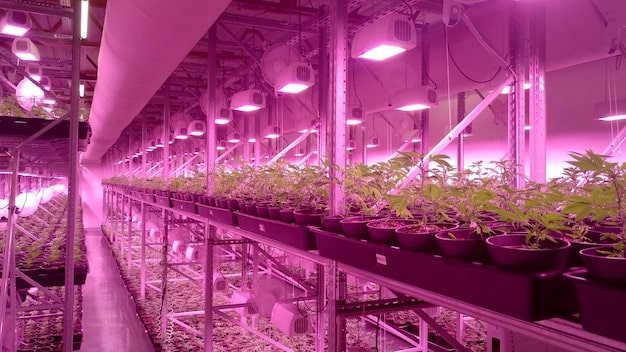
Weather Sensors
Weather sensors provide data on environmental conditions that affect crop water needs. Key measurements include:
- Rainfall: Measures the amount of precipitation.
- Temperature: Affects evapotranspiration rates.
- Humidity: Influences plant transpiration.
- Wind Speed: Impacts evaporation and plant water loss.
This information helps farmers predict future water needs and adjust irrigation schedules accordingly.
Plant Sensors
Plant sensors directly measure plant physiological characteristics, providing insights into plant water status. Examples include:
- Leaf Water Potential Sensors: Measure the water potential in plant leaves, indicating water stress levels.
- Stem Diameter Sensors: Track changes in stem diameter, which can indicate water stress.
- Thermal Imaging: Detects variations in plant temperature, which can signal water stress or disease.
By incorporating these technologies, farmers gain a comprehensive view of the factors influencing their crop’s water needs, enabling more informed and effective irrigation decisions.
Understanding the strengths and limitations of each sensor type is crucial for designing an effective precision irrigation system. The combined use of soil, weather, and plant sensors ensures optimized water management and healthier crop production.
Implementing Precision Irrigation: A Step-by-Step Guide
Implementing precision irrigation involves careful planning and execution. A step-by-step approach can help farmers successfully adopt this technology and maximize its benefits. Where to start with this adoption?
This guide covers everything from initial assessment to ongoing monitoring and optimization. It is intended to simplify the process of adopting this innovative system, making it a more accessible option for farmers.
Assess Current Irrigation Practices
Before implementing precision irrigation, it’s important to assess current irrigation practices. This involves:
- Evaluating Water Usage: Determine how much water is currently being used and where it might be wasted.
- Analyzing Soil Types: Identify variations in soil type across the field.
- Assessing Crop Needs: Understand the specific water requirements of the crops being grown.
This initial assessment provides a baseline for measuring the impact of precision irrigation.
Select Appropriate Sensor Technologies
Choosing the right sensor technologies is crucial. Consider:
- Soil Type: Different sensors perform better in different soil types.
- Crop Type: Different crops have different water needs and may require different sensors.
- Budget: Sensor technologies vary in cost, so it’s important to choose options that fit within the budget.
Consult with experts and other farmers to determine the best sensor technologies for specific needs.
Install and Calibrate Sensors
Proper installation and calibration are essential for accurate data collection. Follow these steps:
- Install Sensors at Appropriate Depths: Place sensors at depths where plant roots are most active.
- Calibrate Sensors According to Manufacturer Instructions: Ensure that sensors are providing accurate readings.
- Connect Sensors to an Automated Control System: Ensure that the system can use the sensor data to control irrigation.
Regularly check and recalibrate sensors to maintain accuracy.
Monitor and Optimize Irrigation Schedules
Precision irrigation is an ongoing process that requires continuous monitoring and optimization. This involves:
- Monitoring Sensor Data Regularly: Track changes in soil moisture, weather conditions, and plant water status.
- Adjusting Irrigation Schedules Based on Data: Modify irrigation schedules to match crop water needs.
- Evaluating Crop Performance: Assess crop health, yield, and quality to determine the effectiveness of the irrigation system.
By following these steps, farmers can successfully implement precision irrigation and reap its many benefits, making agriculture more sustainable and profitable.
Case Studies: Success Stories in US Agriculture
Several successful case studies demonstrate the effectiveness of precision irrigation in US agriculture. These examples highlight the real-world benefits of adopting smart sensor technology. What can we learn from existing implementations?
These cases range from large-scale commercial farms to smaller, family-owned operations. They show how various implementations can significantly improve water use efficiency and crop yields across different contexts, creating real incentives for modernizing practices.
California Vineyards
In California’s drought-prone vineyards, precision irrigation has proven invaluable:
- Problem: Limited water availability threatened grape production.
- Solution: Vineyards implemented soil moisture sensors and weather stations.
- Results:
- Reduced water usage by 25%.
- Improved grape quality and yield.
- Lowered operational costs.
The adoption effectively ensured the sustainability of grape farming in the region.
Midwest Corn and Soybean Farms
In the Midwest, precision irrigation is helping corn and soybean farmers optimize water use:
- Problem: Inconsistent rainfall and inefficient irrigation practices.
- Solution: Farmers installed variable rate irrigation (VRI) systems.
- Results:
- Increased corn and soybean yields by 15%.
- Reduced water usage by 20%.
- Improved nutrient uptake and plant health.
The adoption supports the farmers’ commitment to sustainability.
Florida Citrus Groves
Florida’s citrus growers have also benefited from precision irrigation:
- Problem: Overwatering and disease outbreaks due to high humidity.
- Solution: Citrus groves implemented plant sensors and automated control systems.
- Results:
- Reduced water usage by 30%.
- Decreased disease incidence.
- Improved fruit quality and yield.
The adoption shows a pathway to better resource management and profitability.
These case studies illustrate the transformative potential of precision irrigation in US agriculture. By adopting smart sensor technology, farmers can conserve water, improve crop yields, and enhance the sustainability of their operations.
Challenges and Considerations for Adoption
Despite the numerous benefits of precision irrigation, several challenges and considerations can impact its adoption. Understanding these factors is crucial for successful implementation. So what are the common pitfalls in adoption, and how to overcome them?
The challenges range from initial investment costs to the need for technical expertise. Also, potential solutions and strategies address these barriers.
High Initial Investment Costs
The upfront cost of implementing precision irrigation can be a significant barrier for many farmers. This includes:
- Sensor Technologies: Soil moisture sensors, weather stations, and plant sensors can be expensive.
- Automated Control Systems: These systems require additional investments in hardware and software.
- Installation: Professional installation can add to the overall cost.
To mitigate these costs, farmers can explore government incentives, grants, and financing options.
Technical Expertise
Operating and maintaining precision irrigation systems requires a certain level of technical expertise. Farmers need to be able to:
- Interpret Sensor Data: Understand the data provided by soil moisture, weather, and plant sensors.
- Adjust Irrigation Schedules: Modify irrigation schedules based on sensor data and crop needs.
- Troubleshoot System Issues: Identify and resolve technical problems.
Farmers can overcome this challenge by investing in training programs and seeking support from agricultural consultants and extension services.
Data Management
Precision irrigation systems generate large amounts of data that need to be effectively managed and analyzed. This involves:
- Collecting and Storing Data: Ensuring that data is collected and stored securely.
- Analyzing Data: Using data analytics tools to identify trends and patterns.
- Integrating Data with Other Farm Management Systems: Combining irrigation data with other farm data for a holistic view of operations.
Farmers can leverage cloud-based platforms and data management software to streamline data management processes.
Addressing these challenges requires a strategic approach, combining financial planning, technical training, and effective data management. Overcoming these hurdles will unlock the full potential of precision irrigation, making agriculture more sustainable and efficient.
| Key Point | Brief Description |
|---|---|
| 💧 Water Conservation | Reduces water waste in agriculture, leading to more sustainable use of resources. |
| 📈 Yield Improvement | Optimizes water delivery to crops, enhancing growth and productivity. |
| 💰 Cost Reduction | Lowers expenses related to water and energy consumption, boosting profitability. |
| 🌱 Smart Sensors | Uses advanced sensors to monitor and manage irrigation effectively. |
Frequently Asked Questions (FAQs)
▼
Precision irrigation is an advanced method that uses sensors and data analysis to deliver water to crops efficiently, reducing waste. It works by measuring soil moisture and environmental conditions to optimize irrigation schedules.
▼
Smart sensor technology helps reduce water waste, improve crop yields, and lower operational costs. It ensures plants receive the right amount of water, promoting healthy growth and efficient resource use.
▼
Precision irrigation can typically reduce water waste by up to 20% through the use of smart sensor technology. This is achieved by optimizing water delivery based on real-time conditions and crop needs.
▼
Common sensors include soil moisture sensors, weather stations, and plant sensors. Soil moisture sensors measure water content, weather stations track environmental conditions, and plant sensors assess plant water status directly.
▼
Challenges include high initial costs for sensor technologies and automated systems. Overcoming this requires investing in training and support to utilize the technology effectively.
Conclusion
Embracing precision irrigation through smart sensor technology represents a pivotal shift towards sustainable agriculture in the US. By optimizing water usage, enhancing crop yields, and reducing operational costs, this innovative approach not only addresses pressing environmental concerns but also promises a more resilient and profitable future for American farmers.
